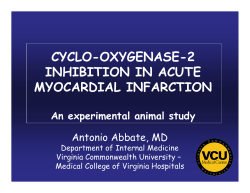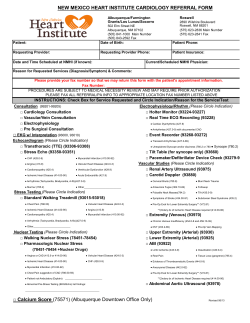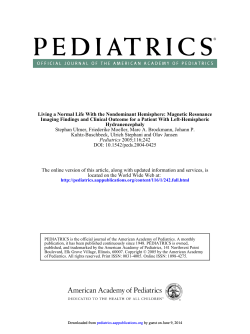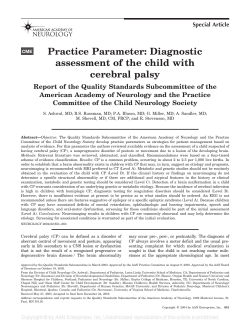
· 871 ·
Zhang WP et al / Acta Pharmacol Sin 2002 Oct; 23 (10): 871-877 · 871 · 2002, Acta Pharmacologica Sinica ISSN 1671-4083 Shanghai Institute of Materia Medica Chinese Academy of Sciences http://www.ChinaPhar.com Neuroprotective effect of ONO-1078, a leukotriene receptor antagonist, on focal cerebral ischemia in rats1 ZHANG Wei-Ping2, WEI Er-Qing3, MEI Ru-Huan, ZHU Chao-Yang, ZHAO Meng-Hui Laboratory of Neurobiology, Zhejiang University Medical School, Hangzhou 310031, China KEY WORDS cerebral ischemia; cerebral arteries; ONO-1078; leukotriene receptor; blood-brain barrier; brain edema ABSTRACT AIM: To determine whether ONO-1078 (pranlukast), a potent leukotriene receptor antagonist, has neuroprotective effect on focal cerebral ischemia in the rat. METHODS: Focal cerebral ischemia was induced by 30 min of middle cerebral artery (MCA) occlusion and followed by 24 h reperfusion. ONO-1078 (0.003-1.0 mg·kg-1) or vehicle (saline 1 mL·kg-1) was ip injected 30 min before MCA occlusion and 2 h after reperfusion. The neurological score, infarct volume, neuron density (in cortex, hippocampus, and striatum), brain edema, and albumin exudation around the vessels were determined 24 h after reperfusion. RESULTS: ONO-1078 slightly improved the neurological deficiency, and dramatically decreased infarct volume and neuron loss which showed a bell shaped dose response effect with highest effect at doses of 0.01-0.3 mg·kg-1. Enlargement of the ischemic hemisphere and albumin exudation were inhibited at doses of 0.01-1.0 mg·kg-1. CONCLUSION: ONO-1078 has the protective effect on focal cerebral ischemia in rats, which is partially attributed to the inhibition of brain edema. This may represent a novel approach to the treatment of acute cerebral ischemia with cysteinyl leukotriene receptor antagonists. INTRODUCTION Arachidonic acid (AA) and its 5-lipoxygenasemetabolite leukotriene C4 (LTC4), one of the cysteinyl leukotrienes, are generated and released during cerebral ischemia in the brains of both patients[1] and experimental animals[2,3]. Cysteinyl leukotrienes are potent inflammatory mediators involved in various diseases. Intracerebral injection of AA or LTC4 resulted in rapid 1 Project supported by the National Natural Science Foundation of China, No 39770270. 2 Now in Department of Biochemistry and Biophysics, University of Pennsylvania Medical School, Philadelphia, PA 19104, USA. 3 Correspondence to Prof WEI Er-Qing. Phn/Fax 86-571-8721-7391. E-mail weieq2001@yahoo.com Received 2001-12-24 Accepted 2002-07-08 breakdown of blood-brain barrier (BBB) followed by vasogenic brain edema[4,5]. Therefore, it is possible that accumulation of AA and its products, such as LTC4, may play a critical role in BBB dysfunction, brain edema, and neuronal death. It was reported that 5-lipoxygenase inhibitors, such as AA-861, nordihydroguaiaretic acid (NDGA), and MK-886, could inhibit brain edema and neurotoxicity after ischemia[3,6,7]. However, whether cysteinyl leukotriene receptor antagonists may also have a neuroprotective effect on cerebral ischemia has not been well explored. ONO-1078, 4-oxo-8-[p-(4-phenylbutyloxy)benzoyl-amono]-2-(tetrazd-5-yl)-4H-1-benzopyran hemihydrate, is a potent antagonist of cysteinyl leukotrienes (LTC4, D4, and E4) which possesses antiinflammatory and anti-asthma effects, now clinically · 872 · Zhang WP et al / Acta Pharmacol Sin 2002 Oct; 23 (10): 871-877 used for treatment of bronchial asthma as a therapeutic drug named pranlukast[8,9]. It dramatically inhibited the plasma exudation induced by LTC4, LTD4, antigen, and other stimuli in the airway, heart, skin, and nose of guinea pigs and rats[10-15]. Kobayashi et al[16] reported that ONO1078 inhibited subarachnoid hemorrhage-induced delayed cerebral vasospasm, and we recently found that this compound protected mice from focal cerebral ischemic injury[17]. Therefore, this study was to clearly determine whether and how ONO-1078 protected acute focal cerebral ischemia in the rats with middle cerebral artery (MCA) occlusion. MATERIALS AND METHODS Chemicals ONO-1078 was kindly gifted by Dr TSUBOSHIMA Masami (Ono Pharmaceutical Co, Osaka, Japan). Anti-rat-albumin antibody was purchased from Santa Cruz, USA; anti-rabbit-HRP IgG from Organo Teknika Corp, Japan; 3, 3'-diaminobensidine tetrahydrochloride (DAB), 2,3,5-triphenyltetrazolium chloride (TTC), hematoxylin, eosin, and chloral hydrate were from Sigma Chemical Co, St Louis, USA. Focal cerebral ischemia One hundred and twelve male Sprague-Dawley rats (Grade II), weighing 250 to 350 g, were from Laboratory Animal Center of Zhejiang Medical University (Certificate 22-9601018, conferred by Zhejiang Medical Laboratory Animal Administration Committee). The animals were anesthetized with ip injection of chloral hydrate (400 mg·kg-1). Polyethylene tube was inserted into the right femoral artery for continuous monitoring of blood pressure using a computer-assisted system (PC-Lab, Nanjing Kelong Inc, Nanjing, China), and for measuring arterial blood pH, pA,o2, and pA,co2 (Blood Gas Analyzer ABL 330, Leidu Inc). Rectal (core) temperature was continuously monitored and maintained at 37 with a thermostatically controlled heating lamp during the surgery. Focal cerebral ischemia was induced by the suture occlusion method[18]. A 4-0 nylon monofilament suture coated with 1 % polylysine [19] was inserted 20- 25 mm to occlude the origins of the anterior cerebral artery, the middle cerebral artery (MCA), and the posterior communication artery, and withdrawn after 30 min of occlusion. In sham-operated animals, the suture was inserted 5 mm from the incision. ONO1078 at doses of 0.003, 0.01, 0.03, 0.1, 0.3, and 1.0 mg·kg-1 or saline (1 mL·kg-1) were ip injected 30 min before MCA occlusion and 2 h after reperfusion. Evaluation of neurological scores Twenty-four hours after reperfusion, the neurological scores were determined by a modified method described by Longa et al[18]: 0, no deficit; 1, failure to extend left forepaw fully; 2, circling to the left; 3, failing to the left; 4, no spontaneous walking with a depressed level of consciousness. Calculation of infarct volumes After evaluation of neurological scores, the animals were anesthetized with chloral hydrate again and decapitated. The brains were quickly removed and coronally dissected into 2 mm thick sections. The brain sections were incubated for 30 min in an isotonic phosphate-buffered saline containing 2 % TTC at 37 , then fixed by immersion in a 10 % buffered formalin solution. All of the brain sections with the caudal face upward were recorded with a digital camera (C-1400, Olympus, Japan), then the imaging data were transferred to a computer and analyzed using an image analyzer (AnalyPower 1.0, Zhejiang University, Hangzhou, China). The areas of both hemispheres and the areas of the infarcted tissue were calculated. The corrected total infarct area was calculated according to Lin et al[20]. The left (nonischemic) stained area (AL) and right (ischemic) stained area (AR) were measured. AL minus AR was defined as the total infarct area of this brain section. Infarct area times the thickness of the section (2 mm) was the infarct volume. Total infarct volume was the sum of the infarct volumes from all of the sections. Subcortical infarct areas were traced manually on the images, and the infarct volume was calculated by computer. Cortical infarct volume was calculated by subtracting the subcortical infarct volume from the total infarct volume. The areas of the right and the left hemispheres in a section at the level of 3.8 to 4.0 mm caudal from bregma were manually traced and calculated. Brain edema was evaluated indirectly as percentage increase of the ischemic hemisphere area, using the following formula: (Ai − An)/An ×100 %. Here, Ai=ischemic hemisphere area, and An=non-ischemic hemisphere area. Histopathology In another series, animals were anesthetized with chloral hydrate and decapitated 24 h after reperfusion, and the brains were quickly removed. Serial coronal sections (10 µm) were obtained by cryoultramicrotomy, fixed in 10 % buffered formalin for 10 min, then stained with hematoxylin and eosin. The normal neurons in the hippocampal CA1 region, temporoparietal cortex III, IV layers (3.8 to 4.0 mm caudal to bregma), and striatum (0.4 to 0.2 mm rostral from Zhang WP et al / Acta Pharmacol Sin 2002 Oct; 23 (10): 871-877 bregma) using an image analyzer described above. Assessment of albumin exudation The albumin immunohistochemistry was performed on coronal sections (10 µm) at the two levels described above. Anti-rat-albumin antibody (1:500), anti-rabbit-HRP IgG (1:1000), and 3, 3'-diaminobenzidine (DAB) were added respectively and successively. An area that contained 2-3 small vessels was selected in cortex and striatum. Then the gray scales were detected with the image analyzer (AnalyPowe 1.0). The albumin exudation was evaluated as percentage increase of the gray scales of ischemic cortex or striatum, using the following formula: (Gi - Gn)/Gn×100 %. Here, Gi=gray scale of ischemic region, and Gn=gray scales of non-ischemic region. Statistical analysis All values are presented as mean±SD. One-way ANOVA or independent-sample t-test was used for statistical analysis of the differences between groups, and paired-sample t-test was used for differences of neuron density between two hemispheres of same brain sections (SPSS 6.0 for Windows, 1993, SPSS inc, USA). P<0.05 was considered statistically · 873 · significant. RESULTS There were no significant differences in body weight, rectal temperature, mean arterial blood pressure, arterial blood pH, pA,co2, pA,o2, and blood glucose before and during MCA occlusion, and 30 min after reperfusion among the groups (Tab 1). ONO-1078 attenuated the injuries of cerebral ischemia at doses from 0.01 to 1.0 mg·kg-1. The neurological scores showed a tendency of attenuation in the rats treated with ONO-1078, but the significant difference was only observed at 0.03 mg·kg-1 (Tab 2). ONO1078 (0.01-0.3 mg·kg-1) significantly reduced the total infarct volumes with the maximum reduction observed at doses 0.03 and 0.1 mg·kg-1 (84.4 % and 83.0 %, respectively). At 0.03 and 0.1 mg·kg-1, cortical infarct volumes were reduced by 81.6 % and 78.8 %, and subcortical infarct volumes by 94.6 % and 96.5 %, respectively (Fig 1). In the saline controls, the ischemic hemisphere areas increased after ischemia, which Tab 1. Summary of selected physiological parameters before, during and 30 min after MCAO. Mean±SD. MAP: mean arterial pressure; MCAO: middle cerebral artery occlusion. Valuables n Body weight/g MAP/mmHg pH pA,co2/mmHg pA,o2/mmHg Glucose/g·L-1 Temperature/ Baseline MCAO 30 min after MCAO 30 min after reperfusion Baseline 30 min after reperfusion Baseline 30 min after reperfusion Baseline 30 min after reperfusion Baseline 30 min after reperfusion Baseline 30 min after reperfusion ONO-1078/mg·kg-1 0.03 0.1 Sham Operation Saline (Control) 0.003 0.01 5 294±18 84±3 86±10 9 298±33 90±9 90±12 8 295±14 86±14 94±9 8 293±34 86±14 91±18 8 298±28 83±10 86±14 85±7 88±15 89±11 86±16 88±5 88±16 97±12 84±19 0.3 1.0 8 285±25 88±11 93±6 8 314±31 90±9 95±8 8 291±31 89±7 91±13 91±9 87±8 90±8 89±8 84±9 90±8 90±16 89±6 7.276±0.019 7.30±0.04 7.29±0.03 7.28±0.04 7.27±0.03 7.28±0.04 7.29±0.04 7.28±0.04 7.273±0.022 7.28±0.03 7.28±0.03 7.29±0.03 7.27±0.03 7.28±0.03 7.29±0.03 7.28±0.04 38.9±1.6 41±5 40.8±2.5 42±5 41±3 42±5 42±6 43±6 40.1±2.5 41±3 41±3 40±4 41±4 41.3±1.4 40.4±1.1 42±7 94±3 90±10 88±8 92±6 86±12 89±18 87±12 84±8 97±7 96±10 86±12 90±12 96±18 100±6 90±8 88±9 1.41±0.20 1.2±0.4 1.3±0.4 1.28±0.28 1.2±0.4 1.17±0.28 1.2±0.4 1.43±0.18 1.20±0.27 1.4±0.3 1.16±0.20 1.4±0.4 36.9±0.4 37.0±0.3 37.1±0.3 37.0±0.3 36.9±0.4 37.1±0.3 37.1±0.3 37.0±0.3 1.1±0.3 1.3±0.3 1.4±0.4 1.3±0.3 37.0±0.3 37.1±0.3 37.0±0.3 37.0±0.3 37.0±0.3 36.9±0.3 37.1±0.3 37.0±0.3 · 874 · Zhang WP et al / Acta Pharmacol Sin 2002 Oct; 23 (10): 871-877 Tab 2. Effect of ONO-1078 on neurological score after MCAO. Mean±SD. bP<0.05 vs saline control. Drugs/mg⋅kg-1 n Sham operation Saline control ONO-1078 0.001 0.003 0.01 0.03 0.3 1.0 5 9 8 8 8 8 8 8 Neurological score 0±0 3.6±0.7 2.8±1.3 2.2±1.3 1.4±1.5 b 2.2±1.4 1.9±1.1 3.0±1.6 Fig 2. Inhibiting effect of ONO-1078 on the percentage increase of ischemic hemisphere areas in rats. n=5-9 per group. Mean±SD. cP<0.01 vs control (saline); fP<0.01 vs sham operation, one-way ANOVA. 0.003, 0.01, and 1.0 mg·kg-1 of ONO-1078 had no significant inhibiting effect (Tab 3). ONO-1078 (0.01-1.0 mg·kg-1) significantly inhibited the increased albumin exudation both in ischemic cortex and striatum, but no dose-dependence was observed (Fig 3). DISCUSSION Fig 1. Inhibiting effect of ONO-1078 on cortical, subcortical, and total infarct volumes in rats. n=5-9 per group. Mean±SD. bP<0.05, cP<0.01 vs control (0, saline), one-way ANOVA. represented the brain edema. ONO-1078, at 0.01-1.0 mg·kg-1, significantly inhibited the enlargement of ischemic hemispheres (Fig 2). ONO-1078 (0.03-0.3 mg·kg-1) also showed protective effect at different brain regions as evaluated by neuron density. ONO-1078 significantly reduced ischemia-induced neuron death at 0.03 and 0.1 mg·kg-1 in the cortex, at 0.03 mg·kg-1 in the hippocampus, and at 0.1-0.3 mg·kg-1 in the striatum. On the contrary, Our results indicated that ONO-1078 possessed the neuroprotective effect on focal brain ischemia of acute phase in rats. This was supported by the evidence that ONO-1078 improved neurological deficiency, decreased infarct volumes both in cortical and subcortical regions, inhibited neuron death, and reduced brain edema and inhibited albumin exudation from cerebral vessels. These findings are in agreement with the protective effect of ONO-1078 on focal cerebral ischemia in mice as we reported[17] and other reports that showed the protective effects of 5-lipoxygenase inhibitors[2,3,6,7]. The dose-effect relationship of neuroprotection by ONO-1078 is not a typical one. Except at the lowest dose (0.003 mg·kg-1), ONO-1078 showed two types of the dose-effect relationship at the doses from 0.01 to 1.0 mg·kg-1. A typical one was observed in inhibiting brain edema and albumin exudation. But there was no significant difference among the larger doses. Another was a bell-shaped relationship in improving neurological deficiency, inhibiting infarct volumes and the reduction of neuron density, with maximal effect at 0.03 and 0.1 mg·kg-1. However, we can not explain Zhang WP et al / Acta Pharmacol Sin 2002 Oct; 23 (10): 871-877 · 875 · Tab 3. Effect of ONO-1078 on neuron density (1×103 cells per mm2) in hippocampus (CA1), cortex, and striatum. Mean±SD. P<0.05, cP<0.01 vs saline control. eP<0.05, fP<0.01 vs sham operation, one-way ANOVA. hP<0.05, iP<0.01 vs non-ischmeic hemisphere, paired t-test. b Drugs/mg·kg-1 Sham operation Saline control ONO-1078 0.003 0.01 0.03 0.1 0.3 1.0 n 5 8 7 7 6 7 6 7 Cortex Non-ischemic Ischemic 0.71±0.13 0.77±0.17 0.71±0.08 0.62±0.05 0.64±0.07 0.63±0.08 0.63±0.10 0.68±0.13 0.66±0.13 0.33±0.05fi 0.39±0.13fi 0.45±0.13ei 0.60±0.10c 0.56±0.11c 0.50±0.10h 0.49±0.03h Fig 3. Inhibiting effect of ONO-1078 on the percentage increase albumin exudation in ischemic cortex and striatum in rats. n=5-8 per group. Mean±SD. cP<0.01 vs control (0, saline). eP<0.05, fP<0.01 vs sham operation, one-way ANOVA. why ONO-1078 is ineffective at higher doses (0.3 and 1.0 mg·kg-1). This bell-shaped dose-effect relationship is often found in neuroprotective agents against brain ischemia, such as GP683 (an adenosine kinase inhibitor) [21] , N G nitro-L-arginine (a NOS inhibitor) [22] , flunarizine (a calcium antagonist)[23], YM90K [an (±)α-amino-3-hydroxy-5-methyl-4-isoxazolepropionic acid (AMPA) receptor antagonist][24] in in vivo and in vitro models of cerebral ischemia. The exact reasons for Hippocampus Non-ischemic Ischemic 0.63±0.11 0.62±0.11 0.62±0.11 0.67±0.08 0.62±0.07 0.63±0.19 0.65±0.07 0.64±0.08 0.67±0.11 0.44±0.11fi 0.46±0.08ei 0.56±0.08h 0.59±0.17b 0.57±0.05 0.58±0.05 0.54±0.08h Striatum Non-ischemic Ischemic 0.57±0.13 0.56±0.14 0.52±0.08 0.54±0.05 0.56±0.10 0.54±0.11 0.65±0.12 0.52±0.08 0.55±0.11 0.31±0.05fi 0.30±0.08fi 0.39±0.11i 0.46±0.17 0.51±0.13b 0.55±0.12c 0.38±0.13i this phenomenon are unclear although it has been proposed that higher doses might cause cerebral vasoconstriction, reduction of blood pressure, and hypoglycemia[25]. In the present study, we detected plasma albumin exudation (which normally can not exudate from vessels) to observe the effect of ONO-1078 on BBB dysfunction. We found that ONO-1078 effectively inhibited albumin exudation at a wide dose range from 0.01 to 1.0 mg·kg-1. This suggests that ONO-1078 may inhibit vasogenic brain edema, and thus produce other neuroprotective effects. However, the action of ONO1078 on BBB dysfunction may not fully explain its neuroprotection, especially for the different effects of larger dose of ONO-1078 (1.0 mg·kg-1). At larger dose, ONO-1078 effectively inhibited brain edema and albumin exudation, but failed to decrease infarct volume and neuron death. Therefore, other mechanisms of ONO-1078 in protecting the ischemic brain need to be further investigated. In summary, we found that ONO-1078 protected focal cerebral ischemia of rats, which at least partly attributed to the inhibition of dysfunction of BBB. These findings suggest a novel approach to treat acute brain ischemia via antagonism of leukotriene receptors. ONO1078 may also act on other disorders associated with BBB dysfunction and brain edema, such as brain trauma and inflammation. ACKNOWLEDGMENTS We thank Dr TSUBOSHIMA Masami, Ono Pharmaceutical Co Ltd, Osaka, Japan, for the supply of ONO-1078, and Dr SHEN Jian-Zhong for helpful discussion. · 876 · Zhang WP et al / Acta Pharmacol Sin 2002 Oct; 23 (10): 871-877 REFERENCES 1 2 3 4 5 6 7 8 9 10 11 12 13 14 Aktan S, Aykut C, Ercan S. Leukotriene C4 and prostaglandin E2 activities in the serum and cerebrospinal fluid during acute cerebral ischemia. Prostaglandins Leukotrienes Esset Fatty Acids 1991; 43: 247-9. Ciceri P, Rabuffetti M, Monopoli A, Nicosia S. Production of leukotrienes in a model of focal cerebral ischemia in the rat. Br J Pharmacol 2001; 133: 1323-9. Rao AM, Hatcher JF, Kindy MS, Dempsey RJ. Arachidonic acid and leukotriene C4: role in transient cerebral ischemia of gerbils. Neurochem Res 1999; 24: 1225-32. Baba T, Black KL, Ikezaki K, Chen KN, Becker DP. Intracarotid infusion of leukotriene C4 selectively increases blood-brain barrier permeability after focal ischemia in rats. J Cereb Blood Flow Metab 1991; 11: 638-43. Papadopoulos SM, Black KL, Hoff JT. Cerebral edema induced by arachidonic acid: role of leukocytes and 5-lipoxygenase products. Neurosurgery 1989; 25: 369-72. Aktan S, Aykut C, Yegen B, Okar I, Ozkutlu U, Ercan S. The effect of nordihydroguaiaretic acid on leukotriene C4 and prostaglandin E2 production following different reperfusion periods in rat brain after forebrain ischemia correlated with morphological changes. Prostaglandins Leukotrienes Essent Fatty Acids 1993; 49: 633-41. Dempsey RJ. Protective effect of the 5-lipoxygenase inhibitor AA-861 on cerebral edema after transient ischemia. J Neurosurg 1996; 85:112-6. Hamilton A, Faiferman I, Stober P, Watson RM, O’Byrne PM. Pranluakast, a cysteinyl leukotriene receptor antagonist, attenuates allergen-induced early- and late-phase bronchoconstriction and airway hyperresponsiveness in asthmatic subjects. J Allergy Clin Immunol 1998; 102: 177-83. Yoshida S, Sakamoto H, Ishizaki Y, Onuma K, Shoji T, Nakagawa H, et al. Efficacy of leukotriene receptor antagonist in bronchial hyperresponsiveness and hypersensitivity to analgesic in aspirin-intolerant asthma. Clin Exp Allergy 2000; 30: 64-70. Hirano T. Peptide leukotriene receptor antagonist diminishes pancreatic edema formation in rats with cerulein-induced acute pancreatitis. Scand J Gastroenterol 1997; 32: 84-8. Shirasaki H, Asakura K, Narita S, Kataura A. The effect of a cysteinyl leukotriene antagonist, ONO-1078 (pranlukast) on agonist- and antigen-induced nasal microvascular leakage in guinea pigs. Rhinology 1998; 36: 62-5. Wei EQ, Xin XH, Wang YC, Chen LP, Zhang LF, Bian RL. Effect of ONO-1078, a leukotriene antagonist, on the cardiovascular responses induced by vagal stimulation, capsaicin and substance P in guinea pigs. Acta Pharmacol Sin1995; 16: 485-8. Wei EQ, Liu JW, Zhang LF, Zhang WP, Bian RL. Effect of ONO-1078, a leukotriene antagonist, on capsaicin- and substance P-induced bronchoconstriction and airway microvascular leakage in guinea pigs. Acta Pharmacol Sin 1996; 17: 209-12. Wei EQ, Wang YC, Chen LP, Tang FD, Bian RL. Effect of a 15 16 17 18 19 20 21 22 23 24 25 leukotriene antagonist, ONO-1078, on electric stimulation of vagus (ESV)-induced bronchoconstriction and microvascular leakage in guinea pigs. Acta Pharm Sin 1994; 29: 487-91. Wei EQ, Zhang WP, Lu ZY, Wu RY. Effects of tachykinin receptor antagonists on leukotriene C4-induced broncho-constriction and airway microvascular leakage in guinea pigs. Chin J Pharmacol Toxicol 1997; 11: 63-5. Kobayashi H, Ide H, Kassell NF, Handa Y, Aradachi H, Findlay JM, et al. Effect of leukotriene antagonist on experimental delayed cerebral vasospasm. Neurosurgery 1992; 31: 550-5. Zeng LH, Zhang WP, Wang RD, Wei EQ. Protective effect of ONO-1078, a leukotriene antagonist, on focal cerebral ischemia in mice. Acta Pharm Sin 2001; 36: 148-50. Longa EZ, Weinstein PR, Carlson S, Cummins R. Reversible middle cerebral artery occlusion without craniectomy in rats. Stroke 1989; 20: 84-91. Belayev L, Alonso OF, Busto R, Zhao WZ, Ginsberg MD. Middle cerebral artery occlusion in the rat by intraluminal suture: Neurological and pathological evaluation of an improved model. Stroke 1996; 27: 1616-22. Lin TN, He YY, Wu G, Khan M, Hsu CY. Effect of brain edema on infarct volume in a focal cerebral ischemia model in rats. Stroke 1993; 24: 117-21. Tatlisumak T, Takano K, Carano RAD, Miller LP, Foster AC, Fisher M. Delayed treatment with an adenosine kinase inhibitor, GP683, attenuates infarct size in rats with temporary middle cerebral artery occlusion. Stroke 1998; 29: 19528. Spinnewyn B, Cornet S, Auguet M, Chabrier PE. Synergistic protective effects of antioxidant and nitric oxide synthesis inhibitor in transient focal ischemia damage. J Cereb Blood Flow Metab 1999; 19: 139-43. Zapater P, Moreno J, Horga JF. Neuroprotection by the novel calcium antagonist PCA50938, nimodipine and flunarizine, in gerbil global brain ischemia. Brain Res 1997; 772: 57-62. Arias RL, Tasse JRP, Bowlby MR. Neuroprotective interaction effects of NMDA and AMPA receptor antagonists in an in vitro model of cerebral ischemia. Brain Res 1999; 816: 299-308. Culmsee C, Stumm RK, Schafer MK, Weihe E, Krieglstein J. Clenbuterol induces growth factor mRNA, activates astrocytes, and protects rat brain tissue against ischemic damage. Eur J Pharmacol 1999; 379: 33-45.
© Copyright 2025





















